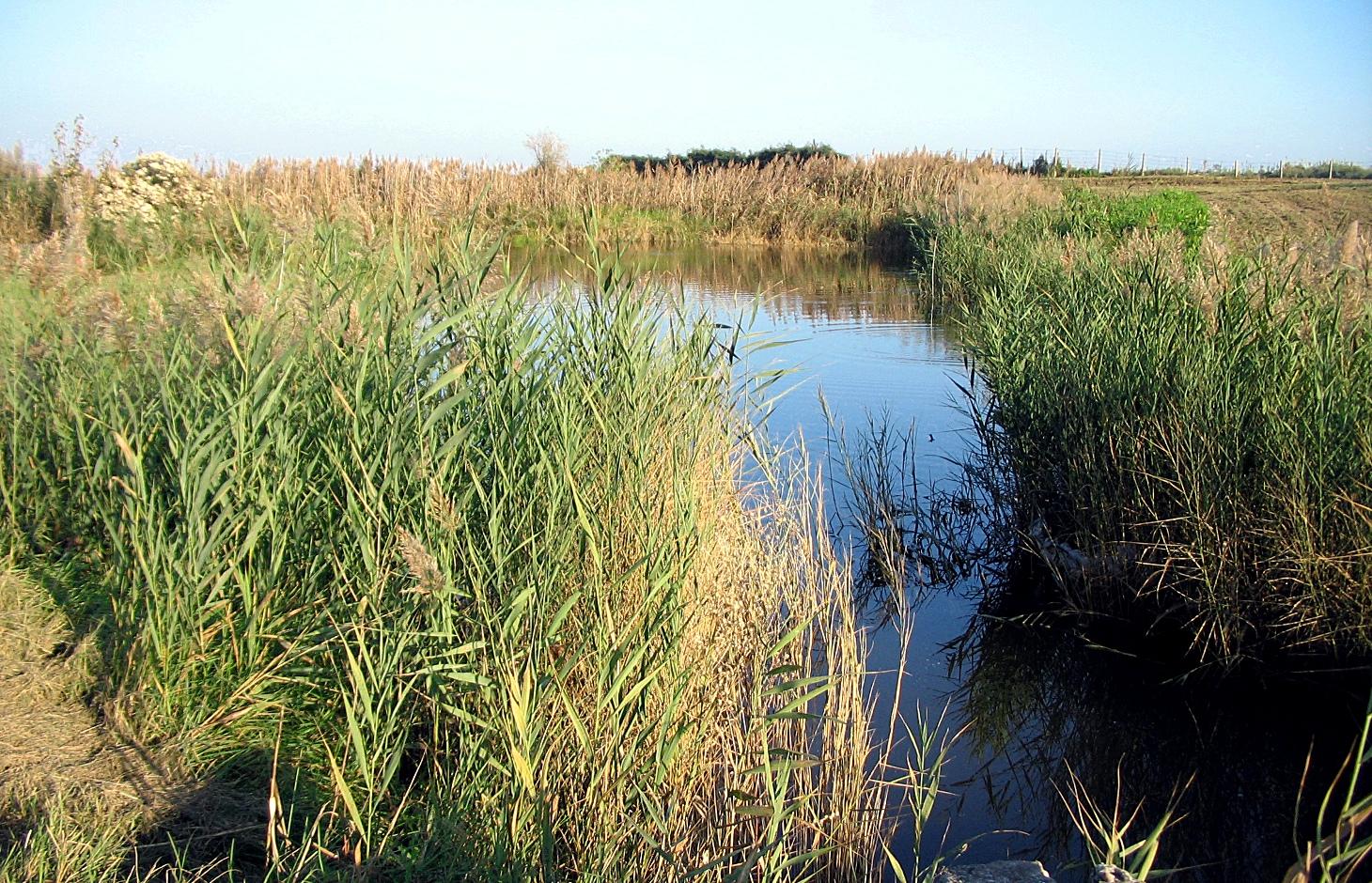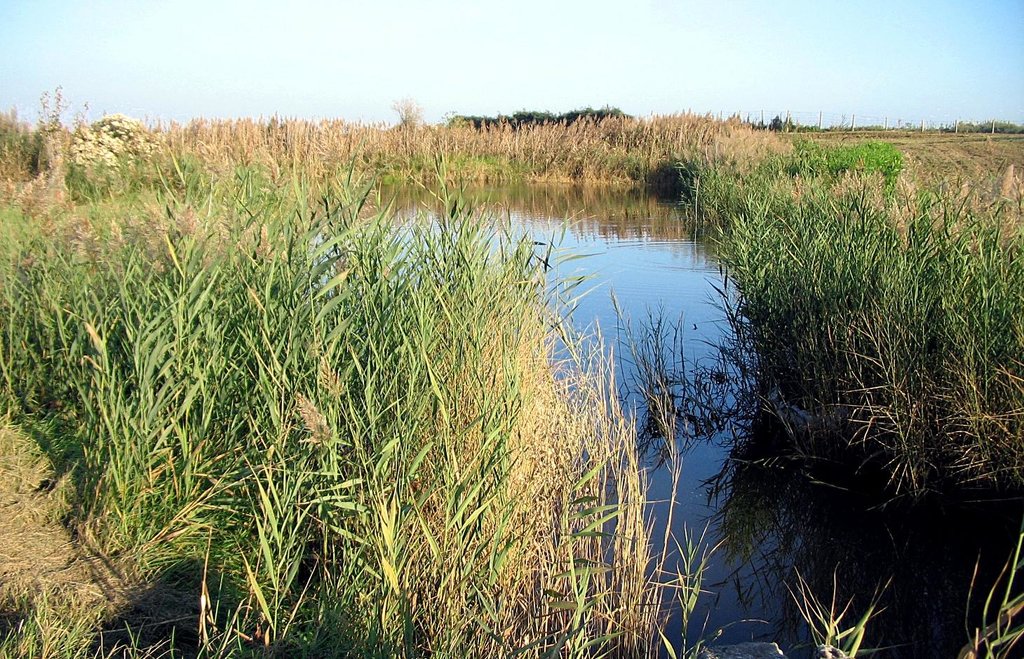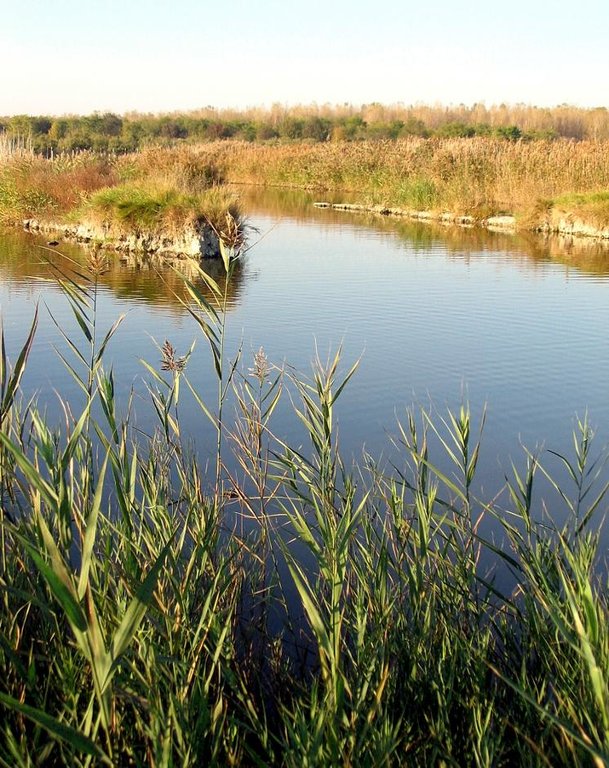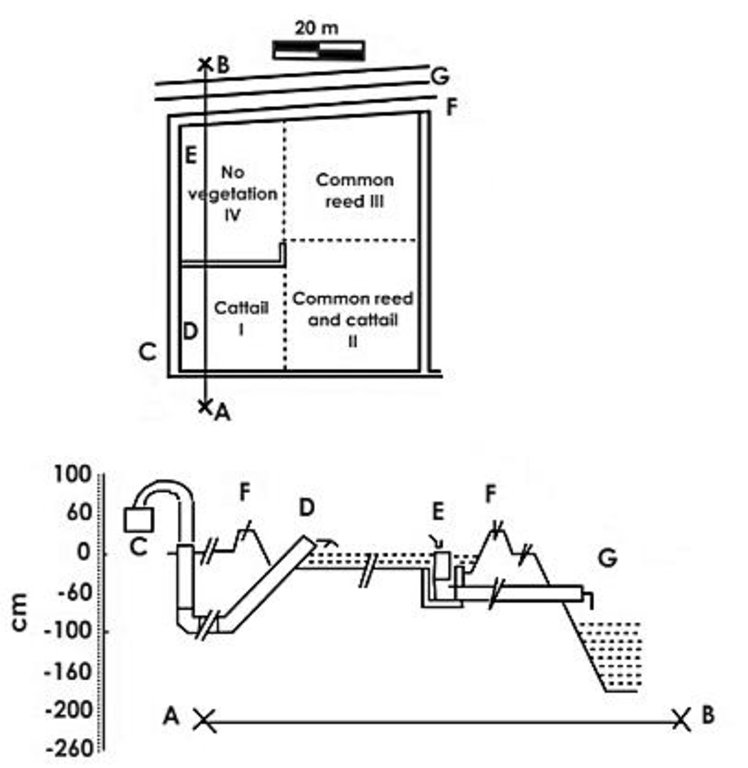Wetland system [意大利]
- 创建:
- 更新:
- 编制者: Nicola Dal Ferro
- 编辑者: –
- 审查者: Fabian Ottiger
Aree umide in territori agrari
technologies_1647 - 意大利
查看章节
全部展开 全部收起1. 一般信息
1.2 参与该技术评估和文件编制的资源人员和机构的联系方式
SLM专业人员:
Morari Francesco
francesco.morari@unipd.it
University of Padova
Via 8 Febbraio 1848, 2, 35122 Padova PD, Italy
意大利
有助于对技术进行记录/评估的项目名称(如相关)
Preventing and Remediating degradation of soils in Europe through Land Care (EU-RECARE )有助于对技术进行记录/评估的机构名称(如相关)
University of Padova (UNIPD) - 意大利1.3 关于使用通过WOCAT记录的数据的条件
(现场)数据是什么时候汇编的?:
17/10/2014
编制者和关键资源人员接受有关使用通过WOCAT记录数据的条件。:
是
1.5 请参阅有关SLM方法的问卷
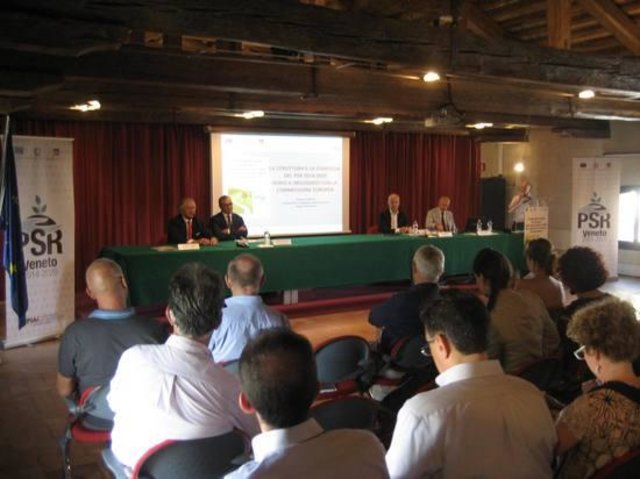
Rural development programme in the Veneto region [意大利]
Developing rural areas in the Veneto region through sustainable land management policies
- 编制者: Nicola Dal Ferro
2. SLM技术的说明
2.1 技术简介
技术定义:
Vegetated water basins for the control of diffuse pollution
2.2 技术的详细说明
说明:
In the last 50 years high intensive monoculture practices implied an oversimplification of agro-ecosystems, a decline of biodiversity and a deterioration in the quality of water resources. The need to prevent nonpoint surface water pollution form agricultural practices has recently led to consider wetlands as effective depurative systems. Construction and maintenance of wetlands have been supported by the Veneto region as an agri-environmental measure through the Rural Development Programme (RDP).
Purpose of the Technology: Wetland systems (WSs) depurate water resources from diffuse pollution, creating a semi-natural environment that promote wildlife and generally biodiversity. WS are characterised by the complete submersion (or for most part of the year) of the soil and a slow water flow that favour environmental and natural functions such as denitrification, flood control, suspended solids sedimentation. Moreover wetlands have been proposed as an alternative land use in reclaimed areas below the sea level which are facing problems of subsidence.
Establishment / maintenance activities and inputs: Thanks to their effectiveness on the improvement of agri-ecosystems, the maintenance and creation of wetland systems have been supported by the regional government in order to reduce the environmental impacts of conventional agriculture practices. The area invested to create a wetland depends on the input pollutants, the size of the area that is considered and the availability of space. The creation of a wetland system provides the establishment of emergent and submerged aquatic macrophytes on a water basin ca. 50 cm depth. The efficacy of water depuration is strictly related to the water residence time.
Natural / human environment: Adopting wetland systems allows to achieve several environmental benefits. Generally, the ecosystem is positively affected by the introduction of a water basin as it provides food, nesting cover and shaded areas to wildlife species. Sediment deposition, anaerobic denitrification conditions and the purifying effect of aquatic plants reduce eutrophication and improve the water quality. Due to their semi-natural structure and high differentiation of plant species, WSs enhance the quality of life through the improvement of agricultural landscape and the creation of recreational areas.
2.3 技术照片
2.5 已应用该技术的、本评估所涵盖的国家/地区/地点
国家:
意大利
区域/州/省:
Italy
有关地点的进一步说明:
Veneto region
2.6 实施日期
如果不知道确切的年份,请说明大概的日期:
- 10-50年前
2.7 技术介绍
详细说明该技术是如何引入的:
- 在实验/研究期间
3. SLM技术的分类
3.1 该技术的主要目的
- 保护生态系统
- 结合其他技术保护流域/下游区域
3.2 应用该技术的当前土地利用类型

农田
- 一年一作
主要农作物(经济作物及粮食作物):
Major cash crop: Maize
Other crops: Wheat, Soybean

水道、水体、湿地
- 沼泽、湿地
注释:
Major land use problems (compiler’s opinion): Diffuse water pollution due to intensive agriculture
Future (final) land use (after implementation of SLM Technology): Other: Oo: Other: wastelands, deserts, glaciers, swamps, recreation areas, etc
如果由于技术的实施而导致土地用途发生变化,则在技术实施前说明土地利的用途。:
Cropland: Ca: Annual cropping
3.3 有关土地利用的更多信息
该技术所应用土地的供水:
- 混合雨水灌溉
注释:
Water supply: rainfed, full irrigation
每年的生长季节数:
- 1
具体说明:
Longest growing period in days: 210 Longest growing period from month to month: March to OctoberSecond longest growing period in days: 180
3.4 该技术所属的SLM组
- 湿地保护/管理
3.6 包含该技术的可持续土地管理措施

结构措施
- S11:其它
注释:
Main measures: structural measures
Specification of other structural measures: Water basin
3.7 该技术强调的主要土地退化类型

生物性退化
- Bh:栖息地丧失
- Bs:质量和物种组成/多样性的下降

水质恶化
- Hp:地表水水质下降
注释:
Main type of degradation addressed: Bh: loss of habitats, Bs: quality and species composition /diversity decline, Hp: decline of surface water quality
Main causes of degradation: soil management, population pressure
Secondary causes of degradation: crop management (annual, perennial, tree/shrub), deforestation / removal of natural vegetation (incl. forest fires)
3.8 防止、减少或恢复土地退化
具体数量名该技术与土地退化有关的目标:
- 防止土地退化
- 减少土地退化
注释:
Main goals: prevention of land degradation
Secondary goals: mitigation / reduction of land degradation
4. 技术规范、实施活动、投入和成本
4.1 该技术的技术图纸
4.2 技术规范/技术图纸说明
Plan and longitudinal view of a constructed wetland sited at the Experimental Farm of University of Padova. A-B: longitudinal section; C: pump; D: wetland inlet; E: wetland outlet; F: side bank; G: stream.
Location: Legnaro. Padova, Italy
Technical knowledge required for field staff / advisors: high
Technical knowledge required for land users: moderate
Main technical functions: control of dispersed runoff: retain / trap, control of dispersed runoff: impede / retard, improvement of water quality, buffering / filtering water
Dam/ pan/ pond
Height of bunds/banks/others (m): 0.3
Width of bunds/banks/others (m): 10
Length of bunds/banks/others (m): 40
Construction material (earth): Wetland banks are made locally by soil. Dimensions refer to 1 m3 water to treat/day
4.3 有关投入和成本计算的一般信息
其它/国家货币(具体说明):
Euro €
注明美元与当地货币的汇率(如相关):1美元=:
0.8
注明雇用劳工的每日平均工资成本:
21.00
4.4 技术建立活动
| 活动 | 措施类型 | 时间 | |
|---|---|---|---|
| 1. | Capital costs for land, site investigation, plants, water control, media | 结构性的 | |
| 2. | Not available | 管理 |
4.5 技术建立所需要的费用和投入
| 对投入进行具体说明 | 单位 | 数量 | 单位成本 | 每项投入的总成本 | 土地使用者承担的成本% | |
|---|---|---|---|---|---|---|
| 其它 | Capital costs. System implementation | ha | 1.0 | 2500.0 | 2500.0 | 30.0 |
| 技术建立所需总成本 | 2500.0 | |||||
5. 自然和人文环境
5.1 气候
年降雨量
- < 250毫米
- 251-500毫米
- 501-750毫米
- 751-1,000毫米
- 1,001-1,500毫米
- 1,501-2,000毫米
- 2,001-3,000毫米
- 3,001-4,000毫米
- > 4,000毫米
农业气候带
- 半湿润
Thermal climate class: temperate
5.2 地形
平均坡度:
- 水平(0-2%)
- 缓降(3-5%)
- 平缓(6-10%)
- 滚坡(11-15%)
- 崎岖(16-30%)
- 陡峭(31-60%)
- 非常陡峭(>60%)
地形:
- 高原/平原
- 山脊
- 山坡
- 山地斜坡
- 麓坡
- 谷底
垂直分布带:
- 0-100 m a.s.l.
- 101-500 m a.s.l.
- 501-1,000 m a.s.l.
- 1,001-1,500 m a.s.l.
- 1,501-2,000 m a.s.l.
- 2,001-2,500 m a.s.l.
- 2,501-3,000 m a.s.l.
- 3,001-4,000 m a.s.l.
- > 4,000 m a.s.l.
5.3 土壤
平均土层深度:
- 非常浅(0-20厘米)
- 浅(21-50厘米)
- 中等深度(51-80厘米)
- 深(81-120厘米)
- 非常深(> 120厘米)
土壤质地(表土):
- 粗粒/轻(砂质)
- 中粒(壤土、粉土)
表土有机质:
- 中(1-3%)
- 低(<1%)
如有可能,附上完整的土壤描述或具体说明可用的信息,例如土壤类型、土壤酸碱度、阳离子交换能力、氮、盐度等。:
Soil fertility is low-medium
Soil drainage/infiltration is medium
Soil water storage capacity is medium
5.4 水资源可用性和质量
地下水位表:
表面上
地表水的可用性:
好
水质(未处理):
仅供农业使用(灌溉)
关于水质和水量的注释和进一步规范:
Water quality (untreated): For agricultural use only (surface water) and good drinking water (groundwater)
5.5 生物多样性
物种多样性:
- 中等
5.6 应用该技术的土地使用者的特征
生产系统的市场定位:
- 商业/市场
非农收入:
- 低于全部收入的10%
相对财富水平:
- 平均水平
- 丰富
个人或集体:
- 个人/家庭
机械化水平:
- 机械化/电动
说明土地使用者的其他有关特征:
Population density: 200-500 persons/km2
Annual population growth: 0.5% - 1%
5.7 应用该技术的土地使用者拥有或租用的平均土地面积
- < 0.5 公顷
- 0.5-1 公顷
- 1-2 公顷
- 2-5公顷
- 5-15公顷
- 15-50公顷
- 50-100公顷
- 100-500公顷
- 500-1,000公顷
- 1,000-10,000公顷
- > 10,000公顷
这被认为是小规模、中规模还是大规模的(参照当地实际情况)?:
- 中等规模的
5.8 土地所有权、土地使用权和水使用权
土地使用权:
- 个人
5.9 进入服务和基础设施的通道
健康:
- 贫瘠
- 适度的
- 好
教育:
- 贫瘠
- 适度的
- 好
技术援助:
- 贫瘠
- 适度的
- 好
就业(例如非农):
- 贫瘠
- 适度的
- 好
市场:
- 贫瘠
- 适度的
- 好
能源:
- 贫瘠
- 适度的
- 好
道路和交通:
- 贫瘠
- 适度的
- 好
饮用水和卫生设施:
- 贫瘠
- 适度的
- 好
金融服务:
- 贫瘠
- 适度的
- 好
6. 影响和结论性说明
6.1 该技术的现场影响
社会经济效应
生产
作物生产
水资源可用性和质量
灌溉用水的可用性
灌溉用水的质量
社会文化影响
文化机会
注释/具体说明:
Increased awareness on biodiversity
娱乐机会
注释/具体说明:
Agro-tourism in improved natural areas
Improved livelihoods and human well-being
注释/具体说明:
Improved agricultural landscape, biodiversity, agro-ecology and generally natural spaces, even for recreational activities. Moreover reduced water pollution.
生态影响
水循环/径流
水质
生物多样性:植被、动物
植物多样性
有益物种
栖息地多样性
6.2 该技术的场外影响已经显现
水资源可用性
旱季稳定可靠的水流
下游淤积
地下水/河流污染
缓冲/过滤能力
6.3 技术对渐变气候以及与气候相关的极端情况/灾害的暴露和敏感性(土地使用者认为的极端情况/灾害)
渐变气候
渐变气候
| 季节 | 气候变化/极端天气的类型 | 该技术是如何应对的? | |
|---|---|---|---|
| 年温度 | 增加 | 好 |
气候有关的极端情况(灾害)
气象灾害
| 该技术是如何应对的? | |
|---|---|
| 局地暴雨 | 好 |
气候灾害
| 该技术是如何应对的? | |
|---|---|
| 干旱 | 不好 |
水文灾害
| 该技术是如何应对的? | |
|---|---|
| 比较和缓的(河道)洪水 | 好 |
其他气候相关的后果
其他气候相关的后果
| 该技术是如何应对的? | |
|---|---|
| 缩短生长期 | 好 |
6.4 成本效益分析
技术收益与技术建立成本相比如何(从土地使用者的角度看)?
短期回报:
消极
长期回报:
积极
技术收益与技术维护成本/经常性成本相比如何(从土地使用者的角度看)?
短期回报:
中性/平衡
长期回报:
积极
注释:
There is a need of initial investment, however wetlands can improve the multifunctionality of agricultural systems and create additional economic opportunities to the agro-ecological benefits.
6.5 技术采用
注释:
Comments on acceptance with external material support: The technology was supported by regional government and some farmers adopted it. However small farms (the majority in the area, just few hectares) can more difficulty adopt the technology due to a wide area required for its implementation.
Comments on spontaneous adoption: Very few adopted spontaneusly the technology
There is a little trend towards spontaneous adoption of the Technology
6.7 该技术的优点/长处/机会
| 编制者或其他关键资源人员认为的长处/优势/机会 |
|---|
|
Improves surface water quality How can they be sustained / enhanced? strenghten and support maintenance activity |
|
Increases recreational areas How can they be sustained / enhanced? Better territorial marketing |
|
Favours biodiversity and faces the loss of habitats How can they be sustained / enhanced? Enlarge wetland areas |
6.8 技术的弱点/缺点/风险及其克服方法
| 编制者或其他关键资源人员认为的弱点/缺点/风险 | 如何克服它们? |
|---|---|
| Reduces crop production | Differentiate the farmers' income |
7. 参考和链接
7.2 参考可用出版物
标题、作者、年份、ISBN:
Treatment wetlands, Kadlec R.H & Wallace S.D., 2008
标题、作者、年份、ISBN:
Programma di sviluppo rurale per il veneto 2007-2013, Regione Veneto, 2007. Dipartimento Agricoltura e Sviluppo Rurale.
链接和模块
全部展开 全部收起链接

Rural development programme in the Veneto region [意大利]
Developing rural areas in the Veneto region through sustainable land management policies
- 编制者: Nicola Dal Ferro
模块
无模块


